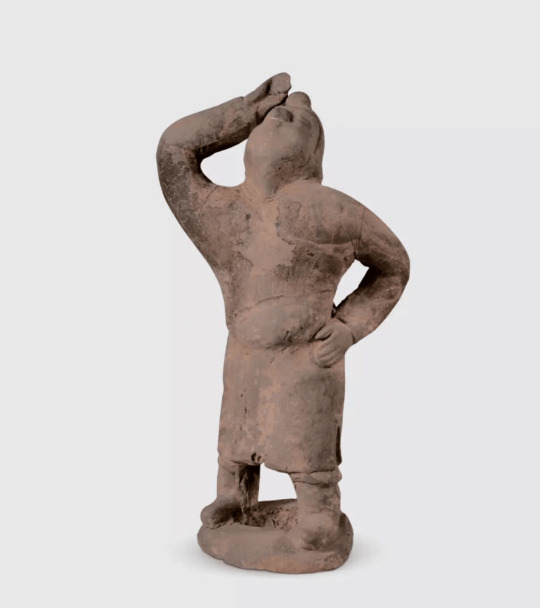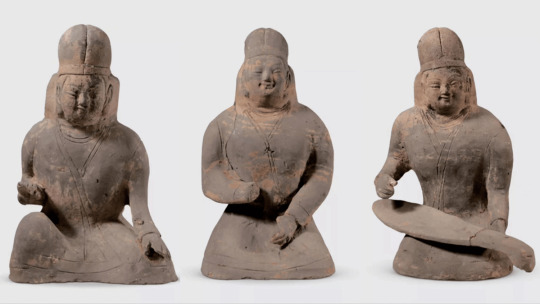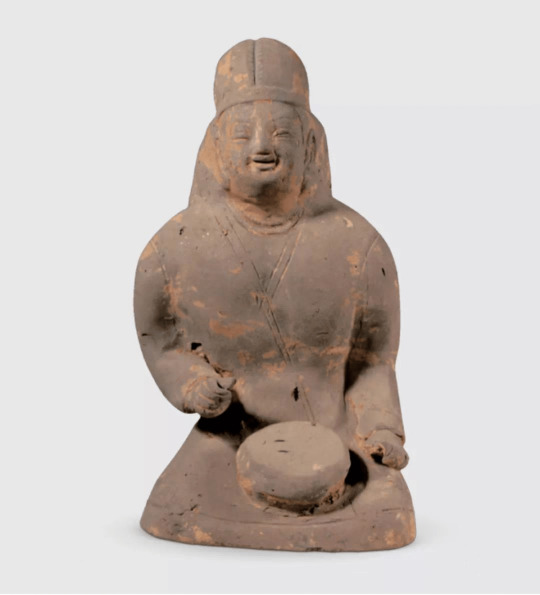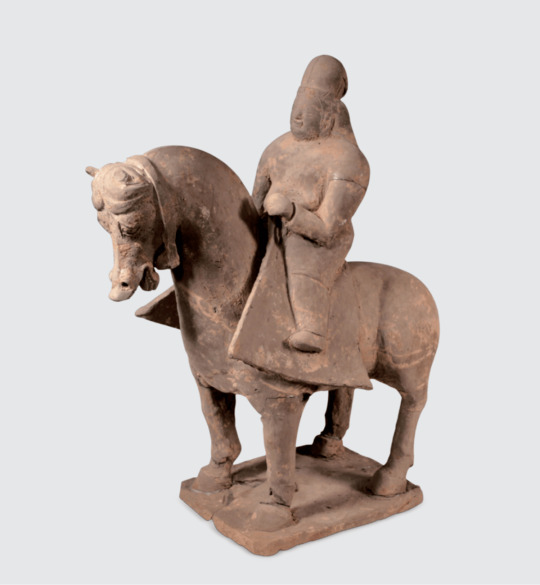#Datong Shanxi Province
Photo






Ancient Terracotta Figurines Unearthed in Shanxi
Archaeologists from the Datong Institute of Cultural Relics and Archaeology recently unearthed a large group of terracotta figurines from a tomb in a group dating to the Northern Wei Dynasty (386-534) in Datong, Shanxi province.
Experts said the new archaeological discovery provides new materials for the study of funeral culture, ethnic costumes and social life of the dynasty.
Various patterns can be seen in the figurines, including musicians, dancers, servants, laborers, animals and vessels.
The relics show that the tomb owners were members of the upper class. Costumes of the female musicians show the integration of national culture and costume development during the period.
#China#Datong Shanxi Province#Ancient Terracotta Figurines Unearthed in Shanxi#Northern Wei Dynasty#ancient tomb#ancient grave#ancient artifacts#archeology#archeolgst#history#history news#ancient history#ancient culture#ancient civilizations#ancient china#chinese history
23 notes
·
View notes
Text


Miners in Public Bathhouse, Datong, Shanxi Province 1996 by Liu Zheng
35 notes
·
View notes
Text
A novel collection of terracotta figures have been recovered in from Northern China, with some pretty surprising subjects and forms!
64 notes
·
View notes
Text

Hanging Temple : Hanging Temple was built on a cliff 75 m ( 246 ft ) of Mt. Hengshan in Hunyuan County, Datong City, Shanxi province, China.
0 notes
Text
Yungang Grottoes
Yungang (Cloud Ridge) Grottoes (云冈石窟) are a sprawling complex of Buddhist cave temples that were carved out of the rocky crag and cliff face at Wuzhou mountain near Datong city in Shanxi Province. The monument was constructed from the mid-fifth century to the early sixth century (ca. 460–524 CE) under the patronage of Northern Wei dynasty rulers and Emperor Wencheng, in particular, as Buddhism…

View On WordPress
0 notes
Text
Xinhua Silk Road: Yungang culture-themed tourism season starts in N. China's Datong on Mon
Xinhua Silk Road: Yungang culture-themed tourism season starts in N. China's Datong on Mon
BEIJING, July 21, 2022 /PRNewswire/ — The 2022 Yungang cultural tourism season, a cultural feast dedicated to crafting north China-situated Datong into a city characterized by being an ancient cultural capital, a cool summer resort and the capital of gourmet, kicked off in Datong of Shanxi Province on July 18.
Since 2000 when the first Yungang cultural tourism season debuted, the seasonal…

View On WordPress
0 notes
Photo









Shanxi Tours offer Tour Packages in all Shanxi Province Tourist destinations (Datong Tours, Pingyao Tours, Yellow River Hukou Waterfall Tours), Shanxi Province Local Travel Agency, Local Price, Thoughtful Service, No middleman.
#Shanxi Tours#Tour Packages#Shanxi Province#Tourist#Datong Tours#Pingyao Tours#Yellow River#Hukou Waterfall Tours#Local Travel Agency#Local Price#Thoughtful Service
2 notes
·
View notes
Photo

Two pandas are formed by solar panels at the Panda Green Energy power plant in Datong, Shanxi Province, northern China. Built in cooperation with the United Nations Development Program, this solar farm covers roughly 1,500 acres and includes an education center that teaches children about sustainable and renewable energy.
See more here: https://bit.ly/2XIaaL4
39.973222°, 113.484361°
Source imagery: Maxar
2K notes
·
View notes
Link
The Shanxi government struggled to find a buyer for the forty-year-old pharmaceutical plant in the northwestern hinterland; a merger with the more successful Shijiazhuang operation went nowhere. When a Hong Kong gangster arrived in 2002 to order several tons of ketamine—paid for with cash—nobody spent much time scrutinizing the deal.
If the ketamine hadn’t been intercepted by Guangdong police on its way to Hong Kong, it’s likely that nobody would have raised the alarm until much later. Even the pharmaceutical firms that were doing well didn’t have much objection to selling ketamine. Only five firms had a license to produce it. But in 2003, authorities carried out an investigation into how a pair of drug dealers got their hands on 150 kilograms of ketamine and determined that illicit manufacturing took place at 35 pharmaceutical firms in eight provinces.
The drug trade compromised not only these former jewels of the command economy, but even the party leadership and bureaucracy.
With the party-state in retreat, alternatives arose. One of them was the red-black nexus, a coalition of bureaucrats and gangsters. The bureaucrats and party officials provided the criminals with legitimacy and organizational support, while the criminals offered the politicians a source of income that could be kicked up to the next level. Private enterprises often benefited from the patronage and protection of the first two categories, adding a third element to that nexus. As long as the money kept coming, higher levels tended to be uninterested in how it was generated.
They also turned a blind eye to practices like land seizures, that filled the coffers of many local governments. Municipalities expropriated state-owned land from residents, sometimes with the help of organized crime muscle, offering it up for sale to private investors. These seizures only became an issue when riots over them made the news.
This contributed to a general atmosphere of social chaos, and it directly assisted in allowing ketamine to be manufactured inside China, instead of being imported through Hong Kong.
One example was Boshe, a village in Guangdong in which the party-state was almost completely absent by the early 2000s, having delegated authority to a local elite organized through the red-black nexus. Close to a third of Boshe residents were involved in the drug trade, all operating under the direction of Cai Dongjia, a local clan patriarch who had become party secretary of Boshe and representative in the Shanwei Municipal People’s Congress. The money he earned through manufacturing ketamine and methamphetamine, as well as by acting as a clearinghouse for shipments of drugs toward Hong Kong, smoothed Cai Dongjia’s climb up the political ladder. His position in the party allowed him to traffic even more dope in turn.
When I describe club tables covered in powder to anyone too young to have been in nightclubs in the 2000s, they’re a little stunned. By the 2010s, ketamine had mostly disappeared.
It disappeared from clubs. It was scarce in karaoke boxes. I still saw it sometimes—snorted by two sculptors during a screening of Beetlejuice at an art space in Tianhe sometime in 2013, offered for sale at Catwalk in Yuexiu around 2014, and flaunted by some girls at a bar in Datong in 2015. But it was nothing like back in the day.
A 2014 study of Beijing, Guangzhou, Shenzhen, and Shanghai’s water treatment plants searched for drugs and their metabolites in wastewater. It discovered a sharp decline in ketamine use, with significant prevalence only in Guangzhou and Shenzhen. An even wider sewage study involving eighteen cities concluded that ketamine use was in decline. A team from Renmin University in Beijing, checking for traces of ketamine and metabolites in the wastewater of several cities, found a 67% decrease in ketamine usage in 2015 alone. The China National Narcotics Control Commission reported a steep decline in busts of “production dens.”
46 notes
·
View notes
Text

Hariti Series
Statue of Hariti (鬼子母 Guizimu) in Shanhua Temple (善化寺 Shànhùasì) in Datong, Shanxi Province, China.
In Chinese Buddhism, Hārītī is also known as Hēlìdì (訶利帝) or Hēlìdìmǔ (訶梨帝母). In Chinese tradition, she is one of the Twenty-Four Protective Devas (二十四諸天 Èrshísì zhūtiān), a group of Dharmapalas who are venerated as protectors of Buddhists and the Dharma.
16 notes
·
View notes
Photo

blowing.up.history
Hanging Temple : Hanging Temple was built on a cliff 75 m ( 246 ft ) of Mt. Hengshan in Hunyuan County, Datong City, Shanxi province, China. It was constructed in Northern Wei Dynasty (386-557) by only one man, a monk named Liao Ran. Hanging Temple has been standing right at the foot of Mt. Hengshan for over one thousand years, Amazing .(Quote from David McCann)
4 notes
·
View notes
Photo





Ian Teh
I. Migrant workers at coal mine outside Datong in Shanxi Province. Datong is dubbed as the coal capital of China and the province Shanxi is the largest producer of coal in the country. China.
II. Workers at a steel and iron plant. Steel and iron production is one of the most energy-intensive industries worldwide, its use of coal and coke as the primary fuel for production means that it has the highest carbon dioxide (CO2) emissions in any industry globally. Tonghua, China.
III. China has been the biggest emitter of CO2 since 2007. In 2013, China exceeded the EU’s emissions on a per capita basis for the first time. It produced 7.2 tonnes per person to the EU’s 6.8 tonnes, whilst the US remained far ahead at 16.5 tonnes per person. However, it is worth noting that 20% of China’s emissions, are driven by demand for Chinese products from consumers in Europe and the US. Benxi, China.
IV. Workers working at a coking plant. The production of coke releases highly toxic substances into the atmosphere that are often carcinogenic. Workers in these industrial plants are often directly exposed to the fumes that are emitted from this industrial process. Benxi, China.
V. A new cooling tower looms above workers returning home from a coal power station. China’s rapid industrialisation over the past 20 years has seen the construction of huge numbers of mainly coal fired power stations. According to the World Resources Institute, throughout history the cumulative emissionsbased on CO2 data, show that the five major emitters—the United States, European Union, China, Russian Federation, and Japan— together contributed to two-thirds of the world’s historic CO2 emissions from 1850 to 2011. Tonghua, China.
#color#street#workers#ian teh#coal#animals#donkeys#group#china#machinery#clouds#vapor#industrial#silhouette
15 notes
·
View notes
Photo

Hanging Temple at Datong, Shanxi Province, China [OC] via /r/ArchitecturePorn https://www.reddit.com/r/ArchitecturePorn/comments/joeiv7/hanging_temple_at_datong_shanxi_province_china_oc/?utm_source=ifttt
1 note
·
View note
Text

Hanging Temple : Hanging Temple was built on a cliff 75 m ( 246 ft ) of Mt. Hengshan in Hunyuan County, Datong City, Shanxi province, China.
271 notes
·
View notes
Photo

Silver and Calcite
Locality: Hongda Mine, Lingqiu Co., Datong Prefecture, Shanxi Province, China.
Size: 4.2 cm by 3.1 cm by 2 cm
#silver#calcite#China#grey#white#Minerals#Crystals#Gems#Gemstones#Science#Nature#Matrix#Geology#Natural Beauty#Hematitehearts#Mineralogy#Rockhound
420 notes
·
View notes
Photo

LES ETERNELS - En 2001, la jeune Qiao est amoureuse de Bin, petit chef de la pègre locale de Datong.
Alors que Bin est attaqué par une bande rivale, Qiao prend sa défense et tire plusieurs coups de feu. Elle est condamnée à cinq ans de prison.
A sa sortie, Qiao part à la recherche de Bin et tente de renouer avec lui. Mais il refuse de la suivre.
Dix ans plus tard, à Datong, Qiao est célibataire, elle a réussi sa vie en restant fidèle aux valeurs de la pègre.
Bin, usé par les épreuves, revient pour retrouver Qiao, la seule personne qu’il ait jamais aimée…
Rien de plus que dans ce synopsis très détaillé, mais tout de façon tellement différente, au bout de monde, avec des mentalités si dépaysantes, qu’on ne dirait pas qu’il s’agit de la même histoire.
Ce récit simple et banal se déroule à la manière unique dont Jia Zhang-ke fait du cinéma à propos de son pays. Rigueur d’écriture et sa souplesse expérimentale, qui permettent à cette histoire des marginaux et des provinces sacrifiées de faire surface sur grand écran.
Le récit est divisé en trois parties dont la deuxième est sans doute la plus réussie. La lente reconstruction d'une femme ayant fait 5 ans de prison nous invite alors à un itinéraire à travers la Chine contemporaine tout à fait passionnant. On y découvre les paysages naturels et urbains, et les scènes de rue de ce pays à part qui se modernise trop rapidement. C'est aussi le meilleur moment pour la comédienne qui conjugue fragilité et malice.
Nous ne sommes que des prisonniers sur la planète Terre, affirme l’un des personnages les plus curieux de ce film, un supposé farfelu qui déclare vouloir créer une agence de tourisme dans la province du Shanxi en se fondant sur de prétendues apparitions d’ovnis. Si des extraterrestres nous observent, peut-être nous trouvent-ils étrangement captifs de nos propres pesanteurs humaines, en effet.
À travers les revers et regains de fortune du couple déchu, le réalisateur rend compte de la fracture sociale provoquée par l'arrivée du capitalisme dans la Chine d’aujourd’hui.
NOTE 14/20 - Une fresque ambitieuse, dépaysante, captivante, qui parle de sacrifice et de résilience dans une Chine chaotique aux prises de sa modernisation aussi brutale qu’un coup de feu parti trop vite.
1 note
·
View note